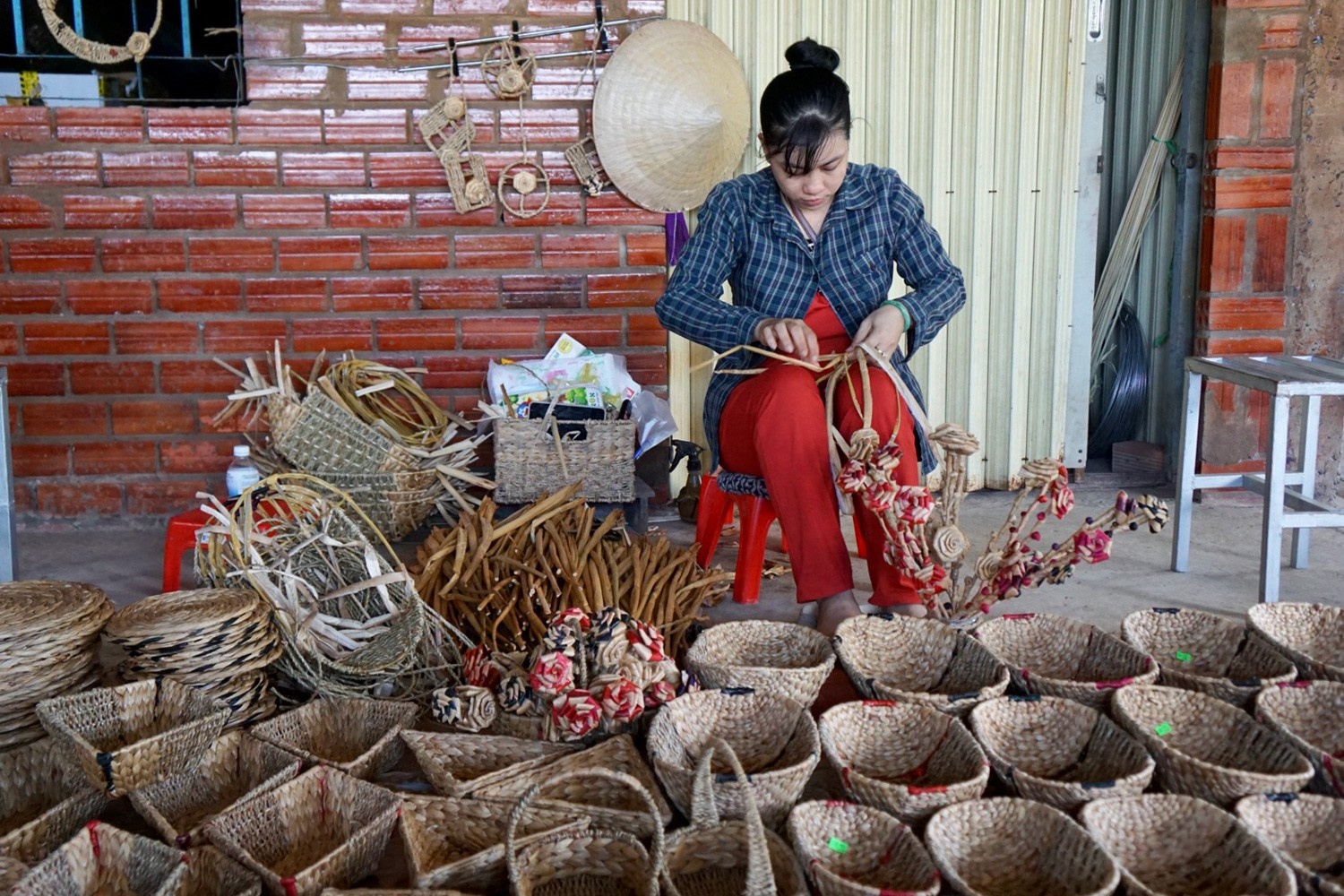North Stars:
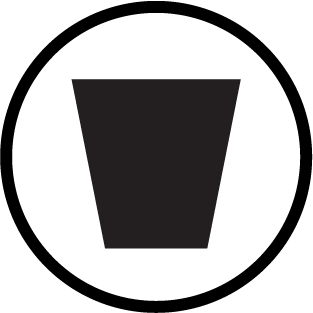
Waste Management

Community Support

Gender Equality
“The women making these water hyacinth products can just about double their income.“
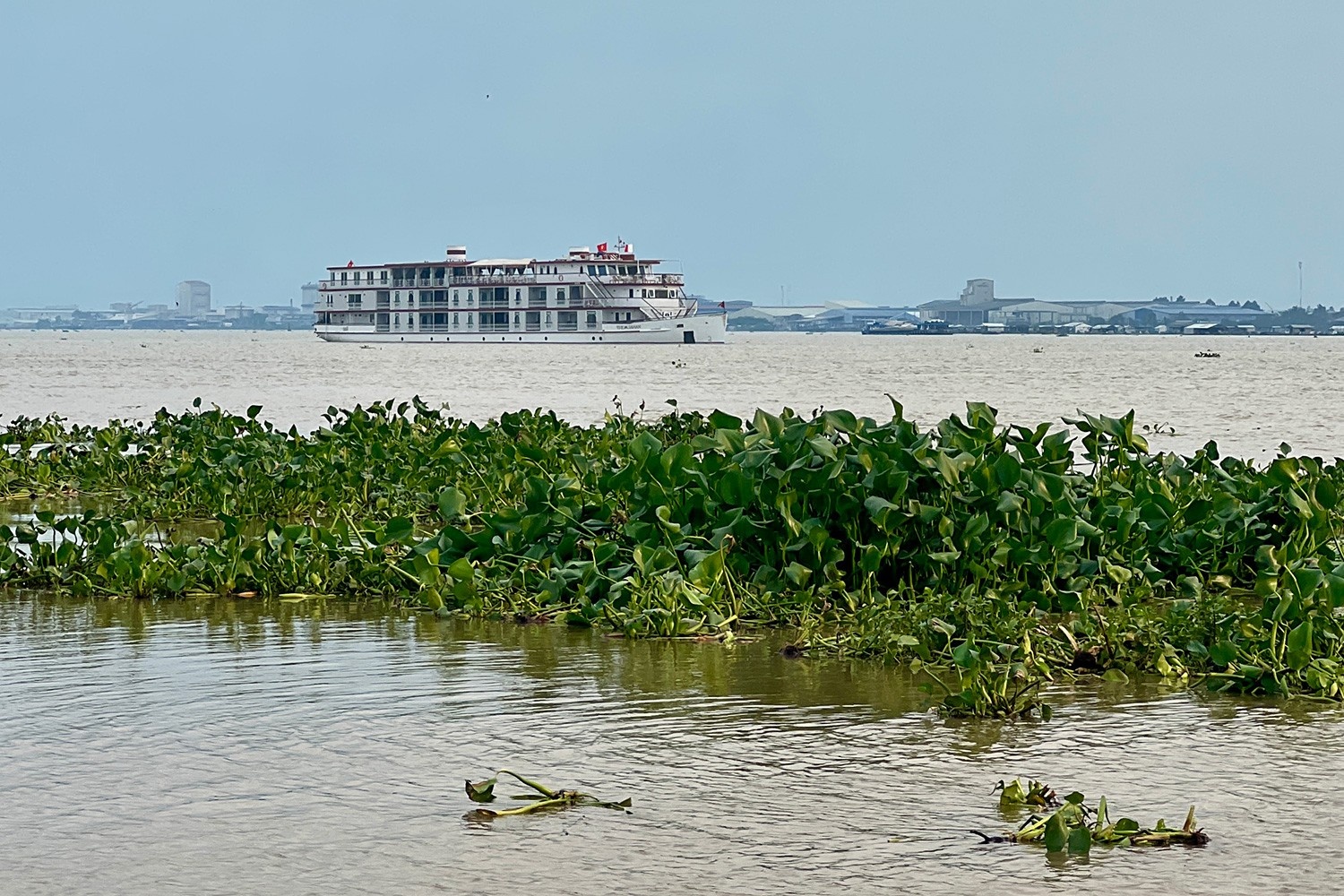
A mat of water hyacinths floating on the Mekong River. Courtesy of Fiona Chandra.
Even if you didn’t know which plant they come from, you’ve likely seen woven baskets and bins made with water hyacinth stems while shopping at stores like Home Depot, IKEA, and Target. Earthy and organic, these home ware items have become more and more popular in recent years, adding texture and style to a space. What you may not know, though, is that the plants these baskets are made from are invasive, overrunning the Mekong River in Southeast Asia.
Setting sail aboard The Jahan, a ship in the fleet of Heritage Line, I noticed the plants immediately. They were everywhere; floating “mats” covered vast swaths of the riverbanks and bobbed atop the water like little islands, their waxy green leaves glistening in the sun. In spring and summer, the plant’s blooming purple flowers blanket the river in a stunning display.
First favored for its beauty, the plant alighted in Southeast Asia during the French colonial period as an ornamental plant. Native to South America, the foreign flora proliferated in the Mekong Delta, thanks to warm temperatures and high nutrient levels. However, like most invasive species, it thrives too much
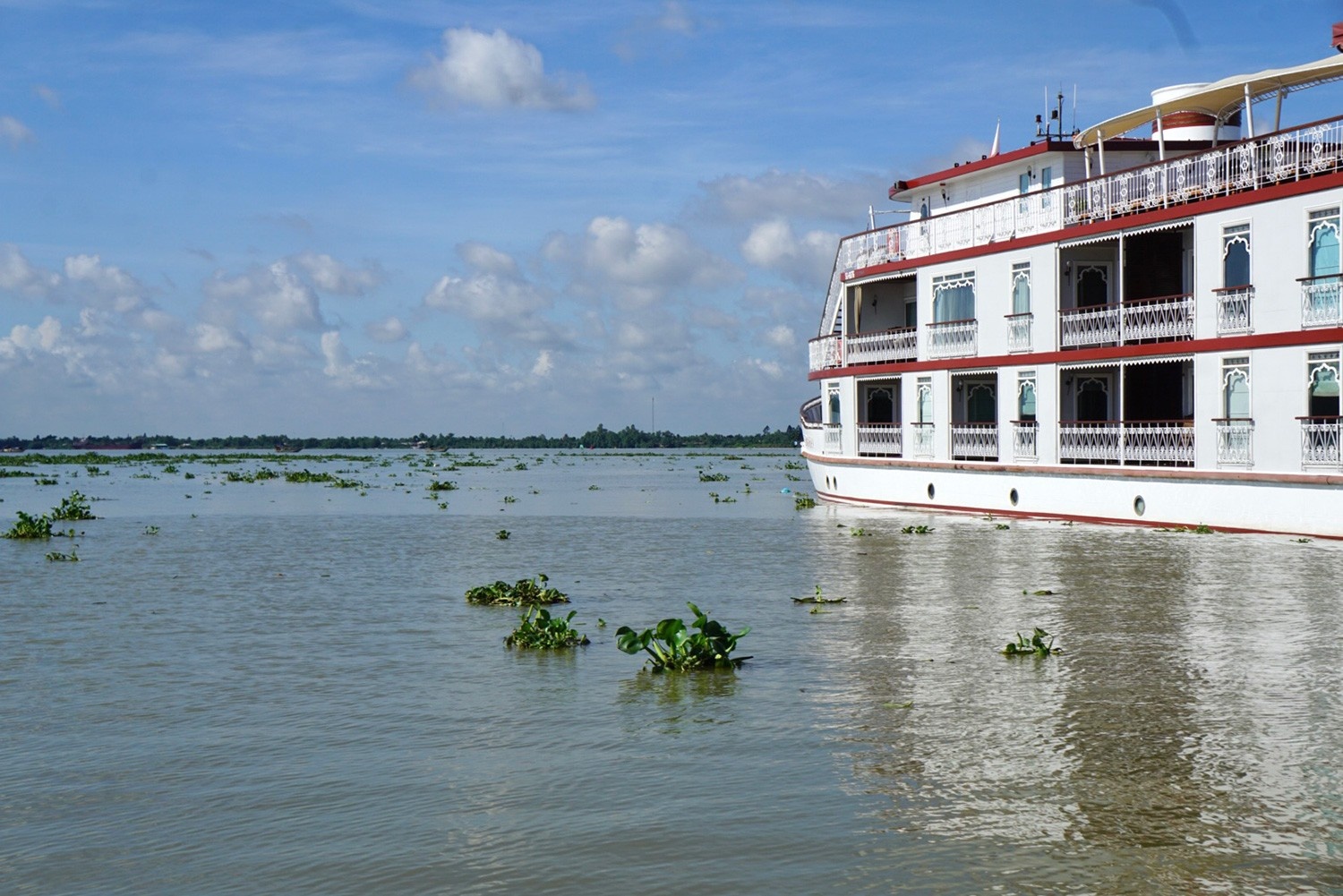
A Heritage Line ship cruises past water hyacinths on the Mekong. Courtesy of Fiona Chandra.
The Impact of Invasive Plants
Tourists may admire the plants while cruising the river, but to locals, it’s a pest that affects their livelihoods. For the people of the Mekong Delta, the river means life. Locals rely on boats as a daily mode of transportation, but freely floating water hyacinths create problems when navigating the canals and waterways.
The plants grow together in dense mats, forcing boats to maneuver around them. Bernard Kervyn, founder of Mekong Plus, an NGO working toward improving rural education and eliminating poverty in Vietnam, says that “many of the canals and rivers are sometimes completely stuck. You cannot cross…because the water hyacinths are so dense.” They also tangle easily in boat propellers, damaging engines.
According to Tri Nguyen, Heritage Line’s Mekong Delta “specialist” and most experienced tour guide, the plant also impacts the fishing industry. According to the WWF, the Mekong River ranks as one of “the world’s most productive inland fisheries,” making it not only vital to the community but also a global food source. The water hyacinth “reduces water quality by blocking sunlight,” says Nguyen, while it “contributes to mosquito breeding due to stagnant water beneath the mats.”
The Vietnamese have tried myriad methods to tackle the problem, from mechanical removal to herbicides, but the plants regrow quickly. Scientists and engineers have also experimented with various eradication methods, like feeding it to earthworms and attempting to turn it into biofuel. In the past two decades, a novel approach to removal has taken hold while providing a small source of income for the women of the Mekong Delta: using the stems to craft baskets, bags, and other accessories.
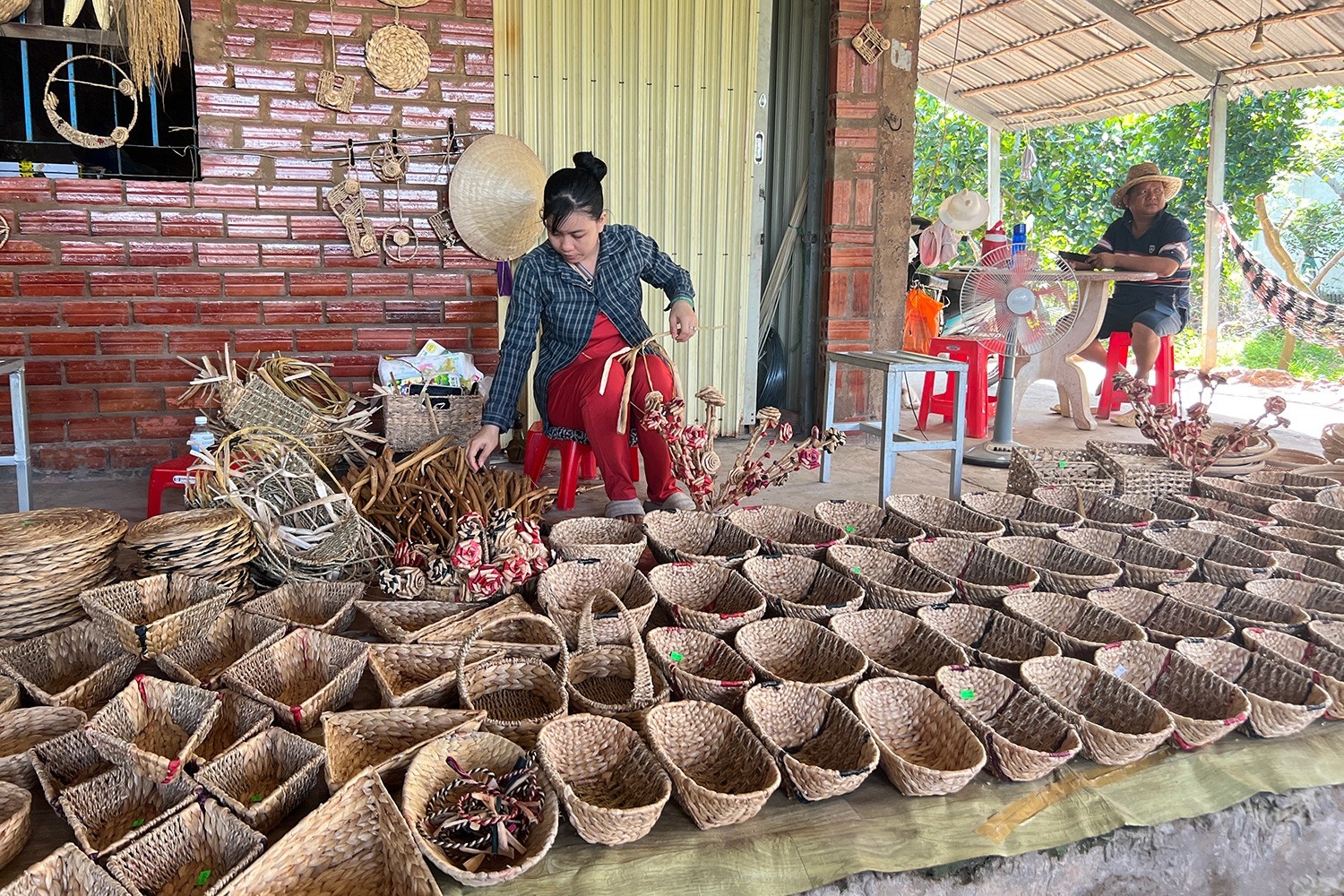
A woman weaving water hyacinth baskets. Courtesy of Fiona Chandra.
From Problem to Potential
I first witnessed the production of these baskets during this Heritage Line cruise along the Mekong River. Our ship was traveling from Saigon to Phnom Penh over three days. Along the way, we would stop at several small communities along the river to observe fisheries, fruit farms, and daily life in the Mekong Delta.
On our second day, we made a stop at Tan Phong Island to visit a fruit farm, since the area is known for its fertile soil. While exploring, we met a young woman selling handwoven baskets, bags, and bracelets. On closer look, we noticed the intricate twists and rolls in each piece — all crafted from dried water hyacinth stems. She explained the material’s surprising strength, then dared us to tear one. We couldn’t. The material felt flexible, which makes it easier for weaving, but was stronger than you’d expect.
To prepare them for weaving, the stems of the water hyacinth are cleaned, halved lengthwise, and dried. Heat and air can speed up the drying process, but in the villages, they’re traditionally dried in the sun, a process that takes about a week. I didn’t have room in my carry-on for a basket, but before we left, each of us had a bracelet quickly woven by hand.
Nguyen says that communities around the Mekong Delta started crafting products using water hyacinth in the early 2000s. NGOs supported the initiative by training women’s cooperatives to produce these handicrafts to sell to tourists or export overseas. Mekong Plus has its own social enterprise arm — that is, a business that generates revenue in order to support its social mission. Its storefront, Mekong Quilts, offers handbags and baskets made from water hyacinths, among other items. According to Kervyn, Japanese customers are especially fond of the baskets. It’s easy to see why — the natural material, understated design, and muted tones align seamlessly with the Japanese concept of wabi-sabi.
Prior to the pandemic, Mekong Quilts had three groups of women producing water hyacinth crafts, getting paid on a per-piece basis (around €5 or just under $6). Unfortunately, since they’ve had to close most of their shops during the pandemic, Mekong Quilts are only able to work with two women right now. Kervyn says these women are typically farmers, like the ones I encountered on Tan Phong Island. “Handicraft is a useful complement for them, especially for the women,” Kervyn says. “This can be done at home…they can be next to the children. The women making these water hyacinth products can about double their income through this,” Kervyn adds.
Woven water hyacinth became a theme throughout the cruise. Having visited Tan Phong in the morning, we had lunch on the ship, then traveled to another island on the river, Binh Thanh. On the way, we noticed several residents harvesting water hyacinth from dense growths on the river’s edge, the stems piling high on their small wooden boats. We were there to visit a local family that makes rattan mats, but the family had also just finished crafting hyacinth baskets. These baskets were set aside for export, so we couldn’t purchase them there, but instead we tried our hands at weaving rattan mats.
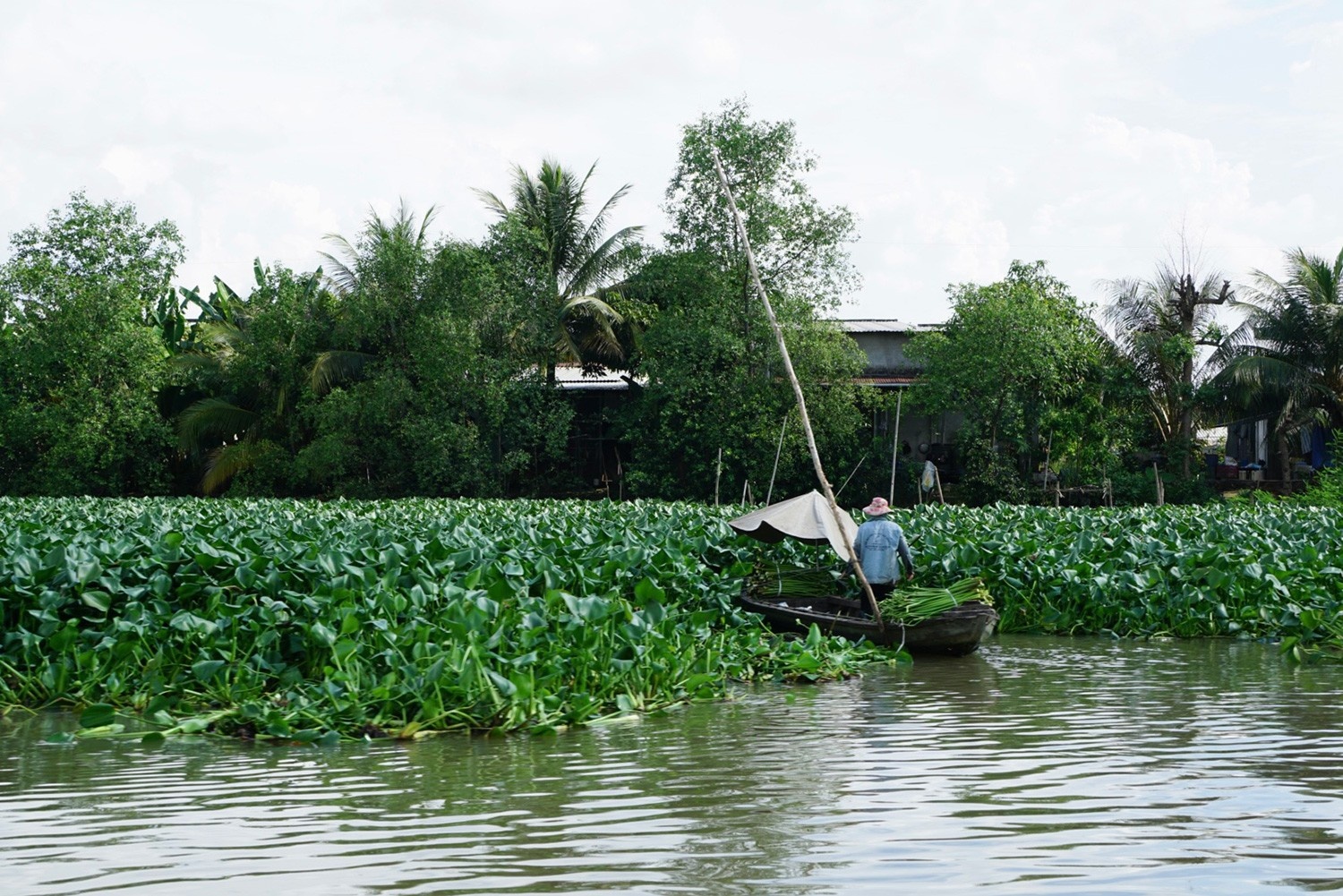
Local resident harvests water hyacinths near Binh Thanh Island. Courtesy of Fiona Chandra.
Where to Find Water Hyacinth Handicrafts
Exploring the Mekong Delta on cruises like Heritage Line allows travelers to purchase directly from the artisans during shore excursions at islands like Tan Phong. Heritage Line’s Tan Phong stop always includes meeting a water hyacinth artisan, though you can also find some souvenir items at the rice paper factory shop at another stop, Cai Be. But if (like me) passengers are unable to purchase bigger items like baskets in the moment, there are other ways to find these Mekong-made goods.
Customers can head to one of Mekong Quilts’ brick-and-mortar stores in Hanoi and Ho Chi Minh City to find water hyacinth bags and other crafts. They offer an online shop as well, but shipping outside of Vietnam can be pricey. International shoppers can find water hyacinth baskets from online retailers like Artera Home, which work directly with Vietnamese artisans to ensure quality and that the artisans are fairly compensated.
But has this widespread use of water hyacinths helped with the original problem: reducing the spread and vast amount of the plants around the Mekong Delta? The answer was unfortunately no — or not yet, at least.
“Its growth rate is extremely high,” says Nguyen. “Local usage alone cannot keep up with its spread.” Still, the initiative has helped manage water hyacinth in certain localized areas and has helped raise wider awareness of the issue. At the very least, the pest has provided another source of livelihood to low-income communities in the Delta.
How to Visit
Heritage Line is a Vietnamese-owned luxury cruise line operating small ship cruises in Vietnam, Cambodia, and Laos. Designed to look like a colonial-era vessel, The Jahan is Heritage Line’s largest ship, with 26 cabins. Sailings aboard The Jahan travel between My Tho (near Saigon) in Vietnam, Phnom Penh, and Siem Reap, stopping at small villages along the way. The company directly employs locals to provide tours and transportation at each stop, highlighting local modes of transit like tuk tuks or buggies. Cruises on The Jahan start at $1,243 per person, including all meals and shore excursions.

Fiona Chandra is a freelance travel and food writer from Indonesia who is currently based in Los
Angeles. Her work has appeared in a variety of publications including The Los Angeles Times,
Fodor’s Travel, Thrillist, and more. Follow her travels (and meals, mostly meals) on Instagram
@gourmetpigs.


